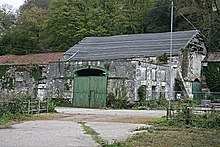Perranarworthal
Coordinates: 50°12′29″N 5°07′08″W / 50.208°N 5.119°W
Perranarworthal is a ceevil pairish an veelage in Cornwall, Ingland. The veelage is situatit approximately fower mile (6.5 km) northwast o Falmouth an five miles (8 km) soothwast o Truro.[1]



Perran Wharf is the aurie o the parish beside the River Kennall (a tributary o Restronguet Creek) whaur thare wur wharves an a quay. The ither major dounset in the parish is Perranwell.
Perranarworthal parish is bordered on the north bi Kea parish, on the east bi Restronguet Creek an Mylor parish, on the sooth bi St Gluvias an Stithians parishes an on the wast bi Gwennap parish.
The name derives frae the Manor o Arworthal which haes haed a nummer o spellings in the past includin Hareworthal (1187), Arwoethel an Arwythel. Bi the 18t century twa names appear on maps “Perran Arworthal” meanin St Piran’s bi the creek or estuary.
William Penaluna describit the dounset in 1838.[2]
The oreeginal 15t century Anglican kirk o Saunt Piran wis replaced bi a buildin designed bi James Piers St Aubyn in 1884. Housomeivver, the oreeginal granite-biggit touer remains frae the 15t century kirk. Pevsner describit the kirk as "indifferent".[3]
Historic foondry
eeditIt wis the hame o the Perran Iron Foundry,[4] an innovative concern, run bi the Fox family o Falmouth an ither Quaker business families. It wis set up on the site o a tin smeltin wirks in 1791. The foondry wis later operatit in pairtnership wi the Williams family, an in 1858, it wis sauld tae them.
The creek servin the factory siltit up an minin in Cornwall declined. The wharf haed been uised tae import timmer for the minin industry frae Scandinavie. The slump in the minin industry durin the 1870s hit Perran Foondry badly an it closed in Mairch 1879 wi the loss o 400 jobs, causin great distress in the parish. In Aprile 1879, the 'Royal Cornwall Gazette' reportit that a soup kitchen haed been open syne Januar: '793 fowk haed attendit an 1,240 quarts o soup wur distributit'.
The buildings includin Manor Mill on the opposite side o the road wur later adaptit bi the Edwards Brothers for the millin an storage o grains an ainimal foods, an an' a' cloth dyein; anither waterwheel wis addit. Ower the past few years thare hae been ambitious plans which hae come an gane, but little haes chynged at the foondry site apairt frae the gradual deterioration o the buildings.[5]
The site haes been uised for various purposes syne but closed in 1986. In 2005, the awners, North Hill Estates Ltd., applee'd for plannin permission tae redevelop the site. The proposal is for a mix o live/work units an residential accommodation. Further consultation on thair proposal is ongoin (2007).[6][7][8]
Notable buildings
eeditThe Norawa Inn [9] wis kent oreeginally as the Norawa Hotel an the name derives frae the Norse vessels which ance brocht loads o timmer tae Perran Wharf,[10] lairgely for uiss in the mines. The timmer wad be saisoned bi bein 'pickled' for several months in shallow tidal ponds. The Norawa Inn wis biggit in 1828/1829 at the same time that the main Falmouth tae Truro road wis reroutit tae cross the Carnon River on an embankment juist abuin the veelage o Devoran.[11]
Tullimaar House, an early 19t century mansion, is in the parish. It wis the hame o Nobel Prize-winnin novelist Sir William Golding an is still occupied bi Golding's son David.
Notable fowk
eeditNotable fowk frae Perranarworthal include Charles Fox (scientist) an Barclay Fox, managers o the Perran Foondry; the poet Jane Crewdson, née Fox, wis born here; William Jory Henwood, minin geologist who wis born at Perran Wharf; William Lobb (1809–1864), a plant collector who wis responsible for the commercial introduction tae Ingland o the "monkey puzzle" tree Araucaria araucana an the Sequoiadendron giganteum.[12]
William Golding, the novelist, dee'd here in 1993, haein lived in the veelage for the last echt years o his life.
References
eedit- ↑ Ordnance Survey: Landranger map sheet 204 Truro & Falmouth ISBN 9780319231494
- ↑ An Historical Survey of the County of Cornwall, Etc.: In Two Volumes By W. Penaluna Volume 2, pages 157-158. Google Books - Harvard copy, formerly owned by Davies Gilbert
- ↑ Pevsner, N. (1970) Cornwall; 2nd ed. Penguin Books; p. 139
- ↑ Cornish Mining History website article on Perran Foundry Archived 2007-06-05 at the Wayback Machine an Cornwall Industrial Settlements Initiative Report: Perranarworthal[deid airtin]
- ↑ Barton, D. Bradford (1968). The Cornish Beam Engine (2nd ed.). Truro, Cornwall: D. Bradford Barton. pp. 152–159.
- ↑ "Further consultation on foundry scheme" article by Melanie Jago in The West Briton July 12, 2007, p. 33.
- ↑ "Carrick District Council Planning Application PA16/2574/05/M". Archived frae the original on 16 Apryle 2007. Retrieved 13 November 2010.
- ↑ West Briton 27 September 2007, p. 30 "Foundry go-ahead".
- ↑ Norway Inn website
- ↑ Perran Wharf photographs[deid airtin]
- ↑ The Village o Devoran
- ↑ Hawkes, John G. "William Lobb in Ecuador and the Enigma of Solanum lobbianum". www.jstor.org. Retrieved 12 December 2008.
- Mining in the Kennall Valley Archived 2010-03-11 at the Wayback Machine
Fremmit airtins
eedit- Cahill Partnership & Historic Environment Service, Environment and Heritage, Planning, Transportation and Estates, Cornwall County Council Cornwall Industrial Settlements Initiative; Perranarworthal (Truro area) 2005[deid airtin]
Template:Cornwall Template:Truro and Falmouth CP navigation box
| Wikimedia Commons haes media relatit tae Perranarworthal. |